2015 Peugeot 208 brakes
[x] Cancel search: brakesPage 119 of 341
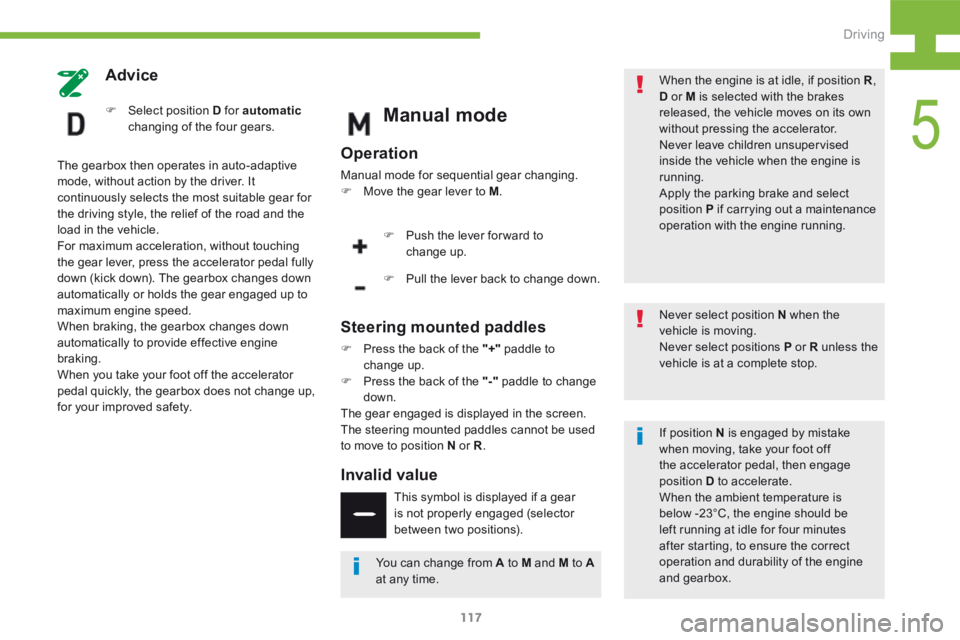
117
208_en_Chap05_conduite_ed01-2015
Advice
F Select position D for automatic
changing of the four gears.
The gearbox then operates in auto-adaptive
mode, without action by the driver. It
continuously selects the most suitable gear for
the driving style, the relief of the road and the
load in the vehicle.
For maximum acceleration, without touching
the gear lever, press the accelerator pedal fully
down (kick down). The gearbox changes down
automatically or holds the gear engaged up to
maximum engine speed.
When braking, the gearbox changes down
automatically to provide effective engine
braking.
When you take your foot off the accelerator
pedal quickly, the gearbox does not change up,
for your improved safety.Manual mode
Operation
Manual mode for sequential gear changing.
F Move the gear lever to M .
F Push the lever for ward to
change up.
F Pull the lever back to change down.
Steering mounted paddles
F Press the back of the "+" paddle to
change up.
F Press the back of the "-" paddle to change
down.
The gear engaged is displayed in the screen.
The steering mounted paddles cannot be used
to move to position N or R .
Invalid value
This symbol is displayed if a gear
is not properly engaged (selector
between two positions). When the engine is at idle, if position R
,
D or M is selected with the brakes
released, the vehicle moves on its own
without pressing the accelerator.
Never leave children unsupervised
inside the vehicle when the engine is
running.
Apply the parking brake and select
position P if carrying out a maintenance
operation with the engine running.
Never select position N when the
vehicle is moving.
Never select positions P or R unless the
vehicle is at a complete stop.
You can change from A to M and M to A
at any time. If position N is engaged by mistake
when moving, take your foot off
the accelerator pedal, then engage
position
D to accelerate.
When the ambient temperature is
below -23°C, the engine should be
left running at idle for four minutes
after starting, to ensure the correct
operation and durability of the engine
and gearbox.
5
Driving
Page 124 of 341
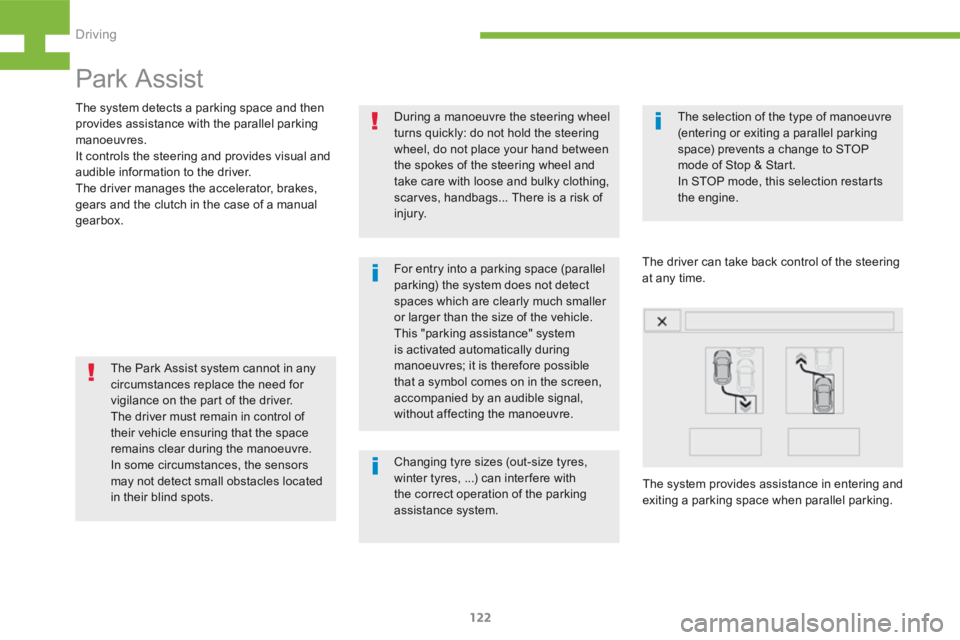
122
208_en_Chap05_conduite_ed01-2015
Park Assist
For entry into a parking space (parallel
parking) the system does not detect
spaces which are clearly much smaller
or larger than the size of the vehicle.
This "parking assistance" system
is activated automatically during
manoeuvres; it is therefore possible
that a symbol comes on in the screen,
accompanied by an audible signal,
without affecting the manoeuvre.The selection of the type of manoeuvre
(entering or exiting a parallel parking
space) prevents a change to STOP
mode of Stop & Start.
In STOP mode, this selection restarts
the engine.
The Park Assist system cannot in any
circumstances replace the need for
vigilance on the part of the driver.
The driver must remain in control of
their vehicle ensuring that the space
remains clear during the manoeuvre.
In some circumstances, the sensors
may not detect small obstacles located
in their blind spots. During a manoeuvre the steering wheel
turns quickly: do not hold the steering
wheel, do not place your hand between
the spokes of the steering wheel and
take care with loose and bulky clothing,
scarves, handbags... There is a risk of
injury.
The driver can take back control of the steering
at any time.
Changing tyre sizes (out-size tyres,
winter tyres, ...) can inter fere with
the correct operation of the parking
assistance system. The system provides assistance in entering and
exiting a parking space when parallel parking.
The system detects a parking space and then
provides assistance with the parallel parking
manoeuvres.
It controls the steering and provides visual and
audible information to the driver.
The driver manages the accelerator, brakes,
gears and the clutch in the case of a manual
gearbox.
Driving
Page 135 of 341
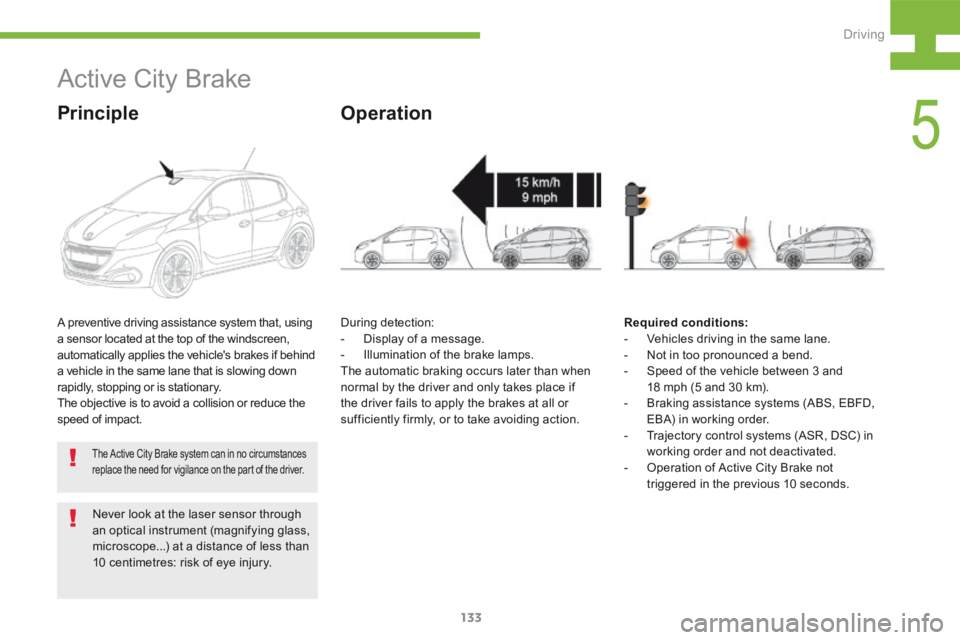
133
208_en_Chap05_conduite_ed01-2015
Never look at the laser sensor through
an optical instrument (magnifying glass,
microscope...) at a distance of less than
10 centimetres: risk of eye injury.
Active City Brake
Principle
A preventive driving assistance system that, using
a sensor located at the top of the windscreen,
automatically applies the vehicle's brakes if behind
a vehicle in the same lane that is slowing down
rapidly, stopping or is stationary.
The objective is to avoid a collision or reduce the
speed of impact.
The Active City Brake system can in no circumstances
replace the need for vigilance on the part of the driver.
Operation
Required conditions:
- Vehicles driving in the same lane.
- Not in too pronounced a bend.
- Speed of the vehicle between 3 and
18 mph (5 and 30 km).
- Braking assistance systems (ABS, EBFD,
EBA) in working order.
- Trajectory control systems (ASR, DSC) in
working order and not deactivated.
- Operation of Active City Brake not
triggered in the previous 10 seconds.
During detection:
-
Display of a message.
- Illumination of the brake lamps.
The automatic braking occurs later than when
normal by the driver and only takes place if
the driver fails to apply the brakes at all or
sufficiently firmly, or to take avoiding action.
5
Driving
Page 136 of 341
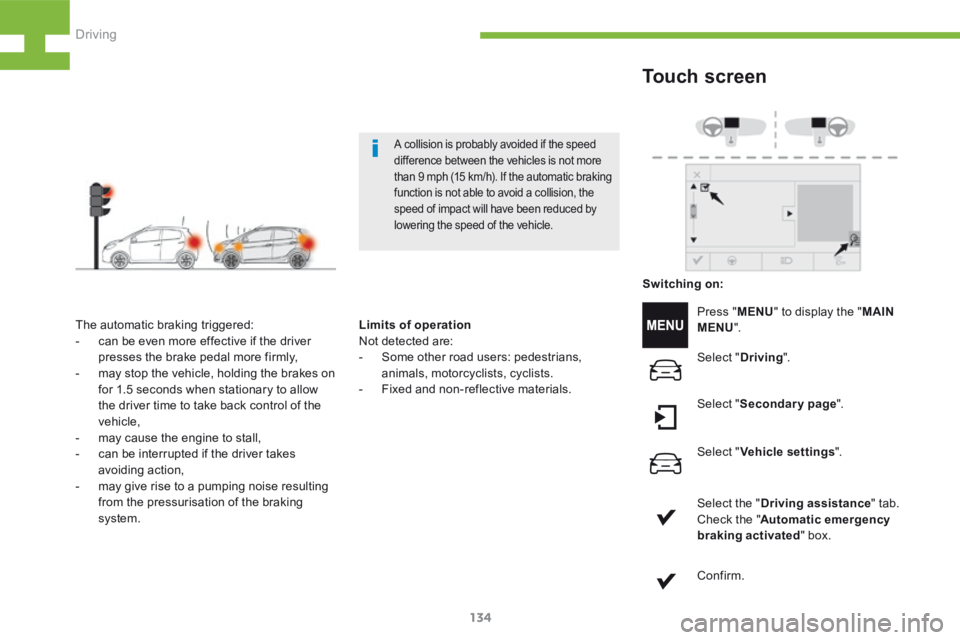
134
208_en_Chap05_conduite_ed01-2015
A collision is probably avoided if the speed
difference between the vehicles is not more
than 9 mph (15 km/h). If the automatic braking
function is not able to avoid a collision, the
speed of impact will have been reduced by
lowering the speed of the vehicle.
The automatic braking triggered:
- can be even more effective if the driver
presses the brake pedal more firmly,
- may stop the vehicle, holding the brakes on
for 1.5 seconds when stationary to allow
the driver time to take back control of the
vehicle,
- may cause the engine to stall,
- can be interrupted if the driver takes
avoiding action,
- may give rise to a pumping noise resulting
from the pressurisation of the braking
system. Limits of operation
Not detected are:
-
Some other road users: pedestrians,
animals, motorcyclists, cyclists.
- Fixed and non-reflective materials.
Touch screen
Press " MENU" to display the " MAIN
MENU ".
Select " Driving ".
Select " Secondary page ".
Select " Vehicle settings ".
Select the " Driving assistance " tab.
Check the " Automatic emergency
braking activated " box.
Switching on:
Confirm.
Driving
Page 138 of 341
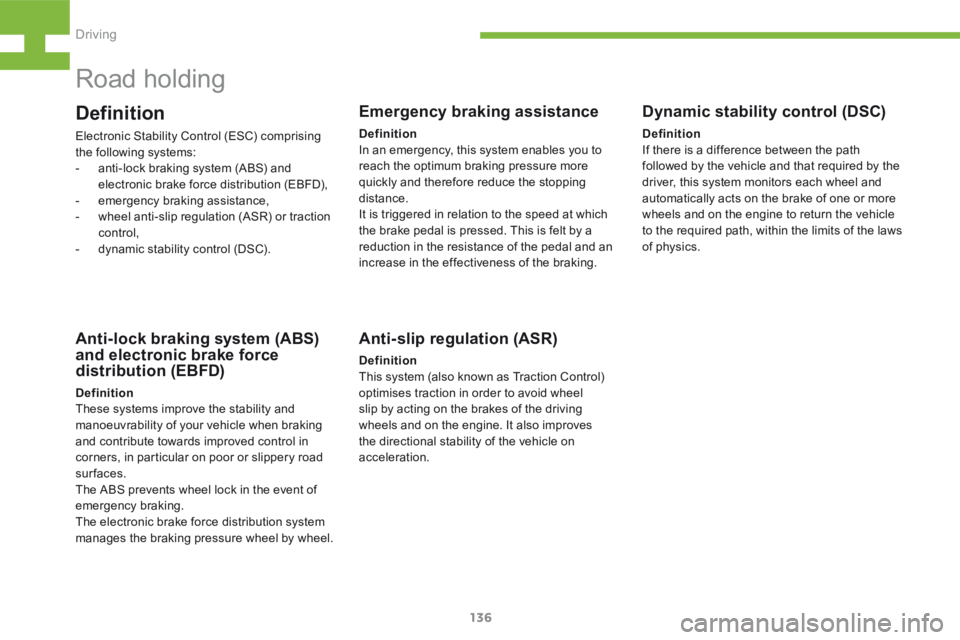
136
208_en_Chap05_conduite_ed01-2015
Road holding
Definition
Electronic Stability Control (ESC) comprising
the following systems:
- anti-lock braking system (ABS) and
electronic brake force distribution (EBFD),
- emergency braking assistance,
- wheel anti-slip regulation (ASR) or traction
control,
- dynamic stability control (DSC).
Anti-lock braking system (ABS)
and electronic brake force
distribution (EBFD)
Definition
These systems improve the stability and
manoeuvrability of your vehicle when braking
and contribute towards improved control in
corners, in particular on poor or slippery road
surfaces.
The ABS prevents wheel lock in the event of
emergency braking.
The electronic brake force distribution system
manages the braking pressure wheel by wheel.
Emergency braking assistance
Definition
In an emergency, this system enables you to
reach the optimum braking pressure more
quickly and therefore reduce the stopping
distance.
It is triggered in relation to the speed at which
the brake pedal is pressed. This is felt by a
reduction in the resistance of the pedal and an
increase in the effectiveness of the braking.
Anti-slip regulation (ASR)
Definition
This system (also known as Traction Control)
optimises traction in order to avoid wheel
slip by acting on the brakes of the driving
wheels and on the engine. It also improves
the directional stability of the vehicle on
acceleration.
Dynamic stability control (DSC)
Definition
If there is a difference between the path
followed by the vehicle and that required by the
driver, this system monitors each wheel and
automatically acts on the brake of one or more
wheels and on the engine to return the vehicle
to the required path, within the limits of the laws
of physics.
Driving
Page 168 of 341
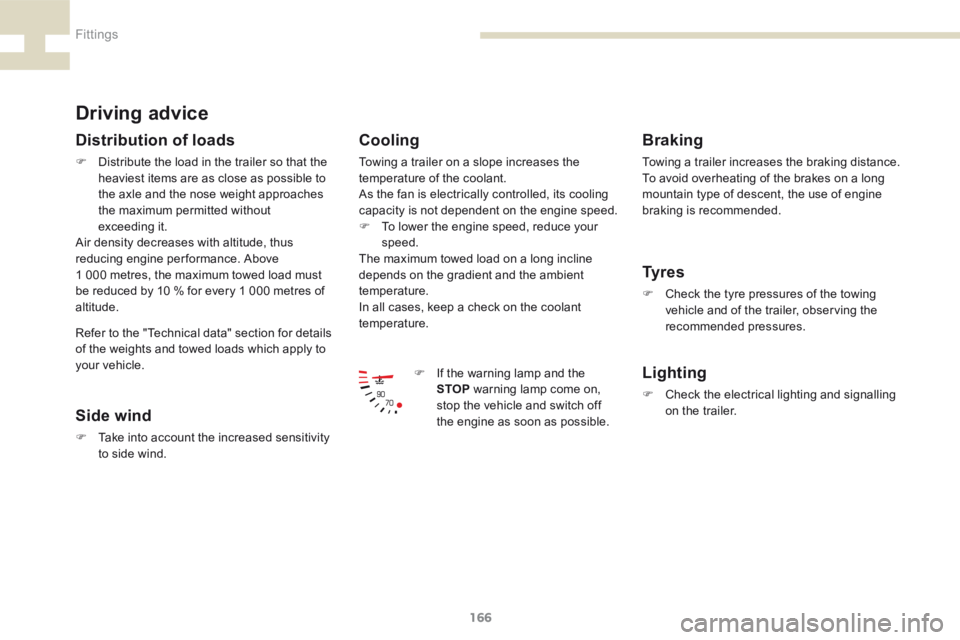
166
208_en_Chap07_ Amenagements_ed01-2015
Driving advice
Distribution of loads
F Distribute the load in the trailer so that the
heaviest items are as close as possible to
the axle and the nose weight approaches
the maximum permitted without
exceeding it.
Air density decreases with altitude, thus
reducing engine performance. Above
1 000 metres, the maximum towed load must
be reduced by 10 % for every 1 000 metres of
altitude.
Side wind
F Take into account the increased sensitivity
to side wind.
Cooling
Towing a trailer on a slope increases the
temperature of the coolant.
As the fan is electrically controlled, its cooling
capacity is not dependent on the engine speed.
F To lower the engine speed, reduce your
speed.
The maximum towed load on a long incline
depends on the gradient and the ambient
temperature.
In all cases, keep a check on the coolant
temperature.
F If the warning lamp and the
STOP warning lamp come on,
stop the vehicle and switch off
the engine as soon as possible.
Braking
Towing a trailer increases the braking distance.
To avoid overheating of the brakes on a long
mountain type of descent, the use of engine
braking is recommended.
Ty r e s
F Check the tyre pressures of the towing
vehicle and of the trailer, observing the
recommended pressures.
Lighting
F Check the electrical lighting and signalling
on the trailer.
Refer to the "Technical data" section for details
of the weights and towed loads which apply to
your vehicle.
Fittings
Page 217 of 341
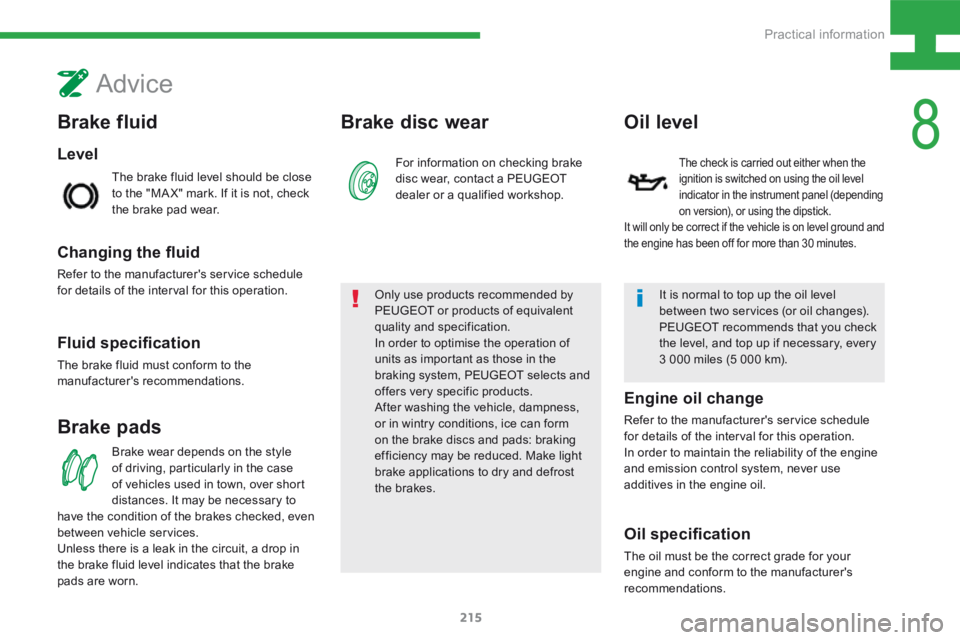
215
208_en_Chap08_Informations-pratiques_ed01-2015
Level
Brake fluid
The brake fluid level should be close
to the "MA X" mark. If it is not, check
the brake pad wear.
Advice
Changing the fluid
Refer to the manufacturer's service schedule
for details of the interval for this operation.
Brake padsBrake disc wear
For information on checking brake
disc wear, contact a PEUGEOT
dealer or a qualified workshop.
Brake wear depends on the style
of driving, particularly in the case
of vehicles used in town, over short
distances. It may be necessary to
have the condition of the brakes checked, even
between vehicle services.
Unless there is a leak in the circuit, a drop in
the brake fluid level indicates that the brake
pads are worn. Only use products recommended by
PEUGEOT or products of equivalent
quality and specification.
In order to optimise the operation of
units as important as those in the
braking system, PEUGEOT selects and
offers very specific products.
After washing the vehicle, dampness,
or in wintry conditions, ice can form
on the brake discs and pads: braking
efficiency may be reduced. Make light
brake applications to dry and defrost
the brakes.
Fluid specification
The brake fluid must conform to the
manufacturer's recommendations.
It is normal to top up the oil level
between two services (or oil changes).
PEUGEOT recommends that you check
the level, and top up if necessary, every
3 000 miles (5 000 km).
Oil level
The check is carried out either when the
ignition is switched on using the oil level
indicator in the instrument panel (depending
on version), or using the dipstick.
It will only be correct if the vehicle is on level ground and
the engine has been off for more than 30 minutes.
Engine oil change
Refer to the manufacturer's service schedule
for details of the interval for this operation.
In order to maintain the reliability of the engine
and emission control system, never use
additives in the engine oil.
Oil specification
The oil must be the correct grade for your
engine and conform to the manufacturer's
recommendations.
8
Practical information
Page 321 of 341
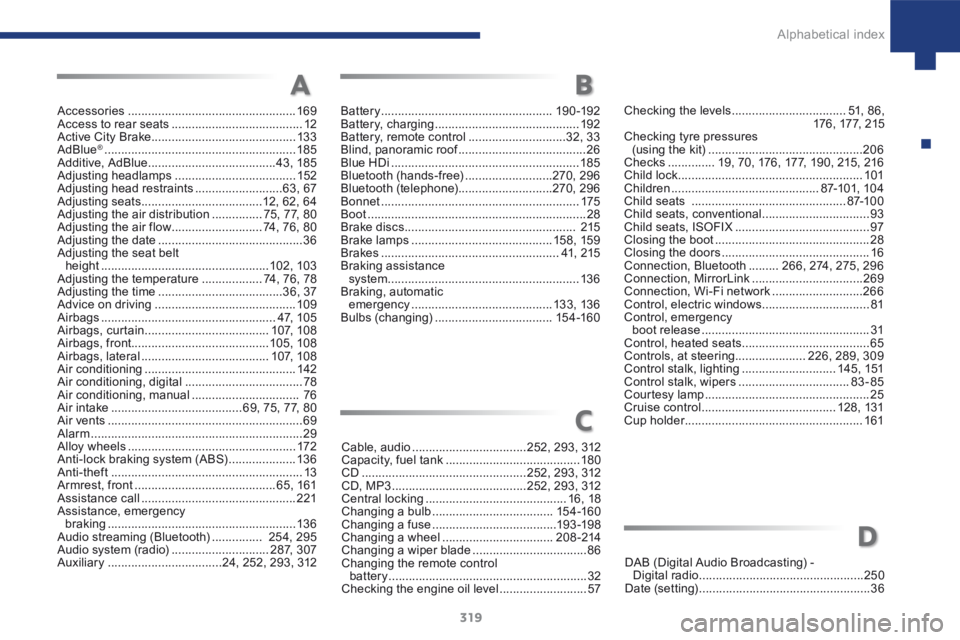
319
208_en_Chap10_index-alpha_ed01-2015
Accessories .................................................. 169
Access to rear seats ....................................... 12
Active City Brake ........................................... 13 3
AdBlue
® ......................................................... 185
Additive, AdBlue ...................................... 43, 185
Adjusting headlamps .................................... 152
Adjusting head restraints ..........................63, 67
Adjusting seats .................................... 12, 62, 64
Adjusting the air distribution ...............75, 77, 80
Adjusting the air flow ...........................74, 76, 80
Adjusting the date ........................................... 36
Adjusting the seat belt height .................................................. 102, 103
Adjusting the temperature .................. 74, 76, 78
Adjusting the time ..................................... 36, 37
Advice on driving .......................................... 109
Airbags .................................................... 4 7, 1 0 5
Airbags, curtain ..................................... 107, 108
Airbags, front ......................................... 105, 108
Airbags, lateral ...................................... 107, 108
Air conditioning ............................................. 142
Air conditioning, digital ...................................78
Air conditioning, manual ................................ 76
Air intake ....................................... 69, 75, 77, 80
Air vents .......................................................... 69
Alarm ............................................................... 29
Alloy wheels .................................................. 172
Anti-lock braking system (ABS) .................... 13 6
Anti-theft ......................................................... 13
Armrest, front .......................................... 65, 161
Assistance call .............................................. 221
Assistance, emergency braking ........................................................ 13 6
Audio streaming (Bluetooth) ............... 254, 295
Audio system (radio) ............................. 287, 307
Auxiliary .................................. 24, 252, 293, 312 Cable, audio
.................................. 252, 293, 312
Capacity, fuel tank ........................................ 180
CD ................................................. 252, 293, 312
CD, MP3 ........................................ 252, 293, 312
Central locking .......................................... 16, 18
Changing a bulb .................................... 15 4 -16 0
Changing a fuse ..................................... 193 -198
Changing a wheel ................................. 20 8 -214
Changing a wiper blade ..................................86
Changing the remote control battery ........................................................... 32
Checking the engine oil level ..........................57Checking the levels
.................................. 51, 8 6 ,
176 , 17 7, 215
Checking tyre pressures (using the kit) .............................................. 206
Checks .............. 19, 70, 176, 177, 190, 215, 216
Child lock ....................................................... 101
Children ............................................ 87-101, 104
Child seats .............................................. 87-10 0
Child seats, conventional ................................93
Child seats, ISOFIX ........................................ 97
Closing the boot .............................................. 28
Closing the doors ............................................ 16
Connection, Bluetooth .........266, 274, 275, 296
Connection, MirrorLink .................................269
Connection, Wi-Fi network ...........................266
Control, electric windows ................................81
Control, emergency boot release .................................................. 31
Control, heated seats ...................................... 65
Controls, at steering .....................226, 289, 309
Control stalk, lighting ............................ 14 5 , 151
Control stalk, wipers ................................. 83-85
Courtesy lamp ................................................. 25
Cruise control ........................................ 128, 131
Cup holder ..................................................... 161
A
C
Battery ................................................... 19 0 -192
Battery, charging ........................................... 192
Battery, remote control ............................. 32, 33
Blind, panoramic roof ...................................... 26
Blue HDi ........................................................ 185
Bluetooth (hands-free) .......................... 270, 296
Bluetooth (telephone) ............................270, 296
Bonnet ........................................................... 175
Boot ................................................................. 28
Brake discs ................................................... 215
Brake lamps .......................................... 15 8, 159
Brakes ..................................................... 41, 215
Braking assistance system ......................................................... 13 6
Braking, automatic emergency .......................................... 13 3, 13 6
Bulbs (changing) ................................... 15 4 -16 0
B
DAB (Digital Audio Broadcasting) -
Digital radio ................................................. 250
Date (setting) ................................................... 36
D
.
Alphabetical index